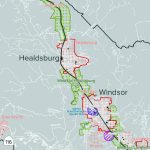Welcome to Monitor Notes, a weekly roundup of news items, event announcements, and updates on past Bay Area Monitor articles.
Setting Boundaries
 As wildfire season approaches, Greenbelt Alliance is hosting a webinar this Thursday from 12:15 to 1 p.m. to discuss how smart planning helped Sonoma County when the 2019 Kincade Fire devastated the area. Firefighters and first responders used the green buffers next to Windsor and Healdsburg’s urban growth boundaries — a planning tool that sets geographic limits on expansion — to defend homes and businesses from the flames. The webinar will include perspective from city officials and county fire protection staff about the ways greenbelts and smart growth help communities build resilience to wildfires. Register here. A separate Mineta Transportation Institute webinar on June 4 from 10 to 10:30 a.m. also will look at city responses to extreme weather based on new analysis it’s done on climate plans in 23 California jurisdictions.
As wildfire season approaches, Greenbelt Alliance is hosting a webinar this Thursday from 12:15 to 1 p.m. to discuss how smart planning helped Sonoma County when the 2019 Kincade Fire devastated the area. Firefighters and first responders used the green buffers next to Windsor and Healdsburg’s urban growth boundaries — a planning tool that sets geographic limits on expansion — to defend homes and businesses from the flames. The webinar will include perspective from city officials and county fire protection staff about the ways greenbelts and smart growth help communities build resilience to wildfires. Register here. A separate Mineta Transportation Institute webinar on June 4 from 10 to 10:30 a.m. also will look at city responses to extreme weather based on new analysis it’s done on climate plans in 23 California jurisdictions.
Advance Notice

Nuria Fernandez (pictured), general manager and CEO of the Santa Clara Valley Transportation Authority, has been named as Woman of the Year by WTS International, an organization focused on the advancement of women in the transportation industry. Fernandez was selected for “her exemplary work, efforts and initiatives in facilitating professional opportunities for women and minorities,” according to a news release. Fernandez also wears several other important hats. In addition to being chair of the American Public Transportation Association (APTA), she also has been invited to serve on MTC’s Blue Ribbon Transit Recovery Task Force. The task force will help decide the next CARES Act distribution formula, assess agencies’ recovery strategies, and make recommendations to reposition transit through institutional and operational changes. It meets for the first time Friday, May 29 at 1:35 p.m.
Out in Algal Bloom
 Warm weather has many people seeking a refreshing dip in the water. But the State Water Resources Control Board is reminding the public to be aware of harmful algal blooms (HABs) in rivers, lakes, and reservoirs that can hurt people and the environment. Most HABs are formed by small microbes called cyanobacteria. Conditions such as rising water temperatures, slow-moving water, and excessive nutrients make cyanobacteria multiply and form harmful blooms. They appear in green, white, red, or brown and may look like thick paint floating on the water, according to the state. Curious about local conditions? The East Bay Regional Park District lists affected lakes and shorelines on its website. Read a Monitor piece, too, for more on the effects of nutrient pollution and how it was emerging as a concern in the Bay Area several years ago.
Warm weather has many people seeking a refreshing dip in the water. But the State Water Resources Control Board is reminding the public to be aware of harmful algal blooms (HABs) in rivers, lakes, and reservoirs that can hurt people and the environment. Most HABs are formed by small microbes called cyanobacteria. Conditions such as rising water temperatures, slow-moving water, and excessive nutrients make cyanobacteria multiply and form harmful blooms. They appear in green, white, red, or brown and may look like thick paint floating on the water, according to the state. Curious about local conditions? The East Bay Regional Park District lists affected lakes and shorelines on its website. Read a Monitor piece, too, for more on the effects of nutrient pollution and how it was emerging as a concern in the Bay Area several years ago.
Climate Control

How will the climate be covered in the 2020 elections? A June 3 Commonwealth Club discussion at 4 p.m. will start the conversation about what to expect on climate change in the race for the presidency. The critical issue has been at the forefront with candidates debating action plans. But with the emergence of the coronavirus pandemic, record unemployment, and economic stagnation, there are new concerns that climate may not get the attention it deserves. Hear from Nathaniel Stinnett (pictured), executive director of the non-partisan Environmental Voter Project, and other speakers about what to expect ahead of November. Register here.
Monitor Notes is produced by Cecily O’Connor. To receive it by email, scroll to the bottom of this page, enter your email address in the box under “RECEIVE EMAIL UPDATES,” and click the red “SIGN UP” button.